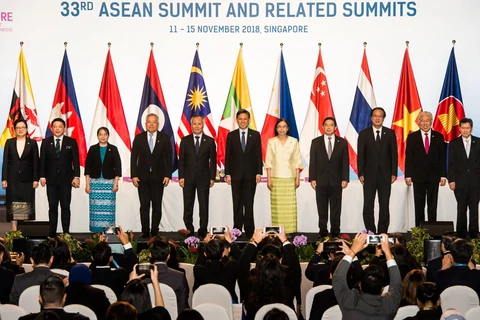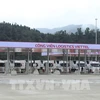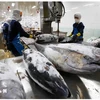Hanoi (VNA) - The past four years have seen a busy journey for the e-commerce market in Southeast Asia and Vietnamese e-commerce growth rate ranked second, just behind Indonesia, in the region, according to Google and Temasek.
A report from Google and Temasek showed the proportion of e-commerce sector in the internet economy was up to 32 percent in the region this year.
The Vietnamese market in particular, the size of the sector is about 2.8 billion USD, with annual growth of 87 percent.
The e-commerce playground in Vietnam for many years has consistently been a competition among Lazada, Shopee, Tiki, Adayroi and Sendo along with mega funding rounds and promotion programmes to attract consumers.
The e-commerce market was growing rapidly thanks to the highest proportion in the region of smartphone users and the number of online sellers was also high, said Pearl Nguyen, head of Vietnam Channel Sales at Google.
According to statistics from Google, it is estimated 3.2 million Vietnamese users annually shop online.
Statistics from the Ministry of Industry and Trade (MoIT)’s E-Commerce and Information Technology Agency showed 70 percent of purchases via social media were made on Facebook this year, up slightly from 2017.
Facebook was more regularly visited by shoppers, with 77 percent of online shoppers using it for purchases, compared to 5 percent on Zalo.
Vietnam’s e-commerce market is predicted to boom in the near future, given that 53 percent of the population uses the internet and nearly 54 million people use smartphones.
According to experts, trade volume via e-commerce reached 4.07 billion USD in 2015, hit 5.1 billion USD in 2016 and 6.2 billion USD in 2017.
The figure is forecast to surge to 10 billion USD by 2020, giving Vietnam a great chance to develop the digital economy.
A recent study by the Institute for Global Leadership under the US’s Tufts University showed Vietnam ranks 48th out of 60 countries globally in terms of rapidly switching to digital economy, and 22nd in terms of digitalisation.
The United Nations E-Government Survey 2018 also pointed out that since 2014, Vietnam has jumped 11 places to the 88th out of 193 countries and territories in the e-government development index. It also ranks sixth in ASEAN, behind Singapore, Malaysia, the Philippines, Thailand and Brunei.
Dang Hoang Hai, head of the MoIT’s Department of E-Commerce and Digital Economy, admitted that infrastructure for the digital economy, including electronic payment, distribution, human resources, information technology and security and safety remained limited.
"Most Vietnamese firms, including e-commerce ones, don’t pay attention to the rapid changes of modern technology," he said.
Experts have called for more investment in technology and human resources amid the fourth industrial revolution. Apart from virtual technology, artificial technology and blockchain are breakthrough technology trends which are applicable in many fields.
Analysts have forecast around 30 percent of Vietnam’s population will shop online by 2020, spending an average 350 USD per person each year.
In particular, social e-commerce is set to thrive next year, especially among small and medium-sized enterprises.
Deputy Minister of Industry and Trade Cao Quoc Hung said apart from refining the national e-commerce payment system, it was necessary to issue favourable mechanisms and optimise business models to effectively use smart supply chain as well as manage intellectual property.-VNA
A report from Google and Temasek showed the proportion of e-commerce sector in the internet economy was up to 32 percent in the region this year.
The Vietnamese market in particular, the size of the sector is about 2.8 billion USD, with annual growth of 87 percent.
The e-commerce playground in Vietnam for many years has consistently been a competition among Lazada, Shopee, Tiki, Adayroi and Sendo along with mega funding rounds and promotion programmes to attract consumers.
The e-commerce market was growing rapidly thanks to the highest proportion in the region of smartphone users and the number of online sellers was also high, said Pearl Nguyen, head of Vietnam Channel Sales at Google.
According to statistics from Google, it is estimated 3.2 million Vietnamese users annually shop online.
Statistics from the Ministry of Industry and Trade (MoIT)’s E-Commerce and Information Technology Agency showed 70 percent of purchases via social media were made on Facebook this year, up slightly from 2017.
Facebook was more regularly visited by shoppers, with 77 percent of online shoppers using it for purchases, compared to 5 percent on Zalo.
Vietnam’s e-commerce market is predicted to boom in the near future, given that 53 percent of the population uses the internet and nearly 54 million people use smartphones.
According to experts, trade volume via e-commerce reached 4.07 billion USD in 2015, hit 5.1 billion USD in 2016 and 6.2 billion USD in 2017.
The figure is forecast to surge to 10 billion USD by 2020, giving Vietnam a great chance to develop the digital economy.
A recent study by the Institute for Global Leadership under the US’s Tufts University showed Vietnam ranks 48th out of 60 countries globally in terms of rapidly switching to digital economy, and 22nd in terms of digitalisation.
The United Nations E-Government Survey 2018 also pointed out that since 2014, Vietnam has jumped 11 places to the 88th out of 193 countries and territories in the e-government development index. It also ranks sixth in ASEAN, behind Singapore, Malaysia, the Philippines, Thailand and Brunei.
Dang Hoang Hai, head of the MoIT’s Department of E-Commerce and Digital Economy, admitted that infrastructure for the digital economy, including electronic payment, distribution, human resources, information technology and security and safety remained limited.
"Most Vietnamese firms, including e-commerce ones, don’t pay attention to the rapid changes of modern technology," he said.
Experts have called for more investment in technology and human resources amid the fourth industrial revolution. Apart from virtual technology, artificial technology and blockchain are breakthrough technology trends which are applicable in many fields.
Analysts have forecast around 30 percent of Vietnam’s population will shop online by 2020, spending an average 350 USD per person each year.
In particular, social e-commerce is set to thrive next year, especially among small and medium-sized enterprises.
Deputy Minister of Industry and Trade Cao Quoc Hung said apart from refining the national e-commerce payment system, it was necessary to issue favourable mechanisms and optimise business models to effectively use smart supply chain as well as manage intellectual property.-VNA
VNA
























